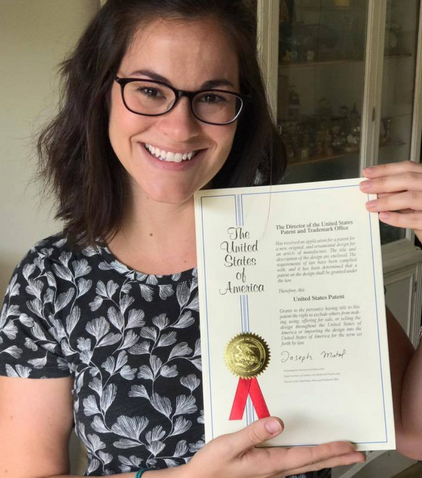-
Maseno Minute – Pad Project Patent
Hello, good morning, and welcome back to the Maseno Minute! From all of us here at TLC, we hope you are doing well, enjoying your Monday, and getting ready for the all of the pumpkin patch visits, Halloween costume planning, and changing leaves October has in store for you.
 This week the Pad Project is excited to announce that we finally have a patent for our pad pattern. Thanks to a wonderful firm in San Diego and the pro-bono work of Knobbe Martens, we now call Design Patent No. D792965 ours. We also want to say a huge thank you to Angela Jeter for helping us make the pad design. She helped us troubleshoot and rework seams and snaps, and we are very thankful.
This week the Pad Project is excited to announce that we finally have a patent for our pad pattern. Thanks to a wonderful firm in San Diego and the pro-bono work of Knobbe Martens, we now call Design Patent No. D792965 ours. We also want to say a huge thank you to Angela Jeter for helping us make the pad design. She helped us troubleshoot and rework seams and snaps, and we are very thankful.This patent is huge for the Pad Project because we now own all rights to this design; this means no one else can privatize the design and use it for a personal business, taking away our ability to make and distribute the pads freely. What we really want to talk about today, though, is why our particular design is so important for the girls reached by the Pad Project.
Now that caring for the environment has become trendy again, reusable pads are making a comeback. Some of you may have seen them on Amazon, ebay, or even in the eco-friendly-natural section of Target. These pads are pretty similar to ours, except they usually come sewn together with liners and base units all attached in one simple and neat package. Our pads differ in that they consists of a base unit and 4 separate liners. So why don’t we make our pads handy and compressed like the ones they sell in Target?
What a lot of people don’t consider is that our pads are made for girls who don’t have access to washing machines. This means that their pads, like all of the rest of their clothes and dishes—and even their bodies—will be washed in cold water. While this is not necessarily a bad thing, it does mean that fewer germs are killed in the actual washing process. Because of this, our pads are made to deconstruct—all liners can be separated from base units because nothing is sewn together—so that girls are able to lay the parts of their pads out to dry while they are at school. Because the pads can be separated, the pads are able to fully dry and the UV light from the sun is able to penetrate all parts of the pad, killing any remaining bacteria. If pads are sewn together, they do not fully dry and all bacteria cannot be killed by the sun’s light, meaning that the girls will get infections they won’t be able to treat due to a lack of medical access and money. The Pad Project wants to help, but we need to help without hurting–giving girls pads that will give them recurring infections is definitely hurting.
Here at TLC, we love new ideas and the gumption to pursue them. However, when people send us pads they have altered by sewing together liners, etc., we simply can’t use them. It wouldn’t be fair to girls across the globe who already have enough experience with things “not being fair.” If you have an idea you think will improve our project, let us know! We would love to listen.
The desire to make these changes makes sense, though. When I first saw the pads I thought, “there are a lot of parts here—why not make a few extra seams and sew it all together?” But I have always had a washing machine and access to as much hot water as I want, and it’s hard to solve a problem when you’re coming from a different definition of normal. Sometimes it’s difficult to help without hurting because our lives and our basis of understanding is so different from the people we are trying to reach. What seemed like a solution to me is a doorway to another set of problems for girls in impoverished areas. For me, the world is a place with hot running water, but it’s important to remember that our own definitions of the world are not universal.
From all of us here at TLC, we hope your Monday is off to a good start, the kind where Sherry from accounting brings in doughnuts, and you’re lucky enough to snag one of those Bavarian crème ones. Our challenge for you as you start this week is to live, only for three days, without hot water—try taking your morning shower in cold water, maybe washing just a pair of socks by hand in the cold water in your kitchen sink—just to see what it would be like if that was your normal. Because the willingness to understand other people’s worlds is important, even if it’s through something as small as water temperature.
From all of us here at TLC, have a great week and a wonderful Monday.




